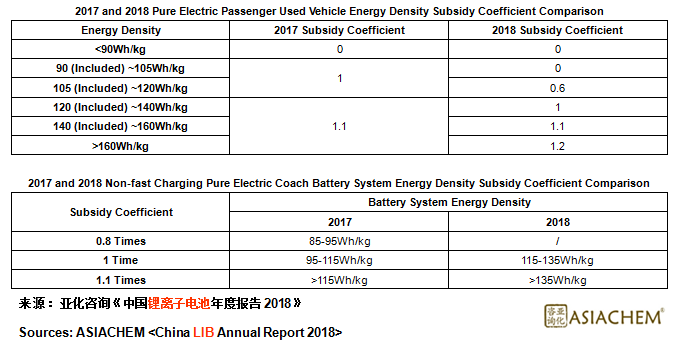China new energy vehicle (NEV) develops rapidly. CAAM data shows that, in the first 4 months of the year 2018, China NEV production and sales volume was 232k and 225k, respectively, YOY increases 142.4% and 149.2%, respectively. Among, BEV production and sales volume was 172k and 168k, respectively, YOY increases 120.6% and 130.5%, respectively; PHEV production and sales volume was 59k and 57k, respectively, YOY increases 239.6% and 226.7%, respectively.
In Apr 2017, MIIT, NDRC and MOST released <Vehicle Industry Middle and Long Term Development Plan>. By 2020, NEV production and sales volume should reach 2M; and by 2025, NEV should occupy more than 20% of production and sales volume of vehicles.
Before, production and sales of NEV can not only received national subsidies but also local ones. As NEV enterprises investment threshold is low, it attracts lots of investors to distribute NEV industry. The Economic Observer data shows that, China had settled more than 200 new energy whole vehicle production projects only from 2015 to H1, 2017, and posted capacity planning has reached 21.24M, which is more than 10 times of target of <Vehicle Industry Middle and Long Term Development Plan>.
However, subsidies of NEV are reducing. In Feb 2018, MOF released <Inform on Adjusting and Perfecting NEV Popularization and Application Subsidies>. The <Inform> adjusted and perfected NEV popularization and application subsidies from 3 aspects: 1) Increase technical threshold requirement; 2) Perfect NEV subsidy standard; 3) Classify and adjust operating mileage requirement. The <Inform> started implement since Feb 12, 2018, and transition period is from Feb 12, 2018 to Jun 11, 2018.
In specific, 2017 and 2018 pure electric passenger used vehicle energy density subsidy coefficient comparison and non-fast charging pure electric coach battery system energy density subsidy coefficient comparison are as below.

Influenced by this, profits of NEV enterprises greatly decreased contemporary. Take BYD as an example, the company Mar 2018 Sales Report shows that, in 2018, the company accumulated NEV sales volume reached 29,637; the company 2018 Q1 Report shows that, in Q1, 2018, the company realized CNY 24.738bn operation revenue, YOY increases 17.54%, net profit was only CNY 102M, YOY decreases 83.09%.
Before, Shenzhen Stock Exchange asked BYD to give the reason why the company achievement declined in Q1. BYD responded that, benefit from new energy passenger used vehicle sales volume largely increased, the company NEV overall sales volume realized strong increase compare with the same period in 2017. However, influenced by reduce of NEV subsidies, NEV business gross profit greatly declined.
Meanwhile, the company stated that, aiming at 2018 increasing NEV subsidy standard technical threshold requirement, the company has accelerated product transformation, and actively does planning and development of products which meet subsidy technical threshold requirement, especially pays attention to increasing and optimizing of power battery system energy density and whole vehicle energy consumption to meet technical requirement of higher subsidy coefficients. For example, in terms of power battery system energy density, in order to gain 1.1 times NEV subsidy, the company will distribute pure electric bus which power battery system energy density is higher than 135Wh/kg; in order to gain 1.1 times NEV subsidy, the company has launched passenger used vehicle which power battery system energy density is higher than 140Wh/kg already. It is estimated that, after new subsidy standard implementing on Jun 11, subsidies of pure electric passenger used vehicles of high driving mileage, high energy density and low energy consumption of the company will greatly increase, and estimates to significantly improve the profitability of NEV of the company.
Up to the end of 2017, the company had 16GWh power battery capacity, among, ternary battery has 6GWh, while LFP battery has 10GWh. In 2018, the company will further expand 10GWh ternary battery capacity and total battery capacity will reach 26GWh.
NEV subsidy will continue reducing, and estimates to be fully cancelled at the end of 2020. ASIACHEM believes that, in order to adapt the subsidy reducing policy, to develop high energy density power battery must be enforced. The NEV industrial chain enterprises will show the status of ‘strong is always strong’ in the future, those enterprises which have advanced technologies and large-scale will be survived, while those which have outdated capacity will be gradually eliminated. So, enterprises should reduce irrational investments, and invest more capitals on independent R&D and product quality, only by this China NEV industry can move towards the track of sound progress.